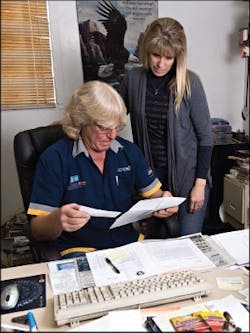Blake Brueggeman could sum up the state of his business in three words: “We were hemorrhaging.”
Back in the late 1990s and early 2000s, Integrity Auto Repair was a bare-bones 1,200-square-foot facility operating in the sleepy mountain town of Grand Junction, Colo. Brueggeman didn’t own a lift. He didn’t have an advertising or marketing budget.
The only thing Brueggeman did have was debt, some $20,000 worth.
His little shop was bleeding him dry.
“I was in $10,000 to my NAPA jobber alone and that was in the 90-day category,” he says. “I had no idea how I was going to stay open. I was at the point where I was thinking it was time to close up.”
The Backstory
Unlike many shop owners, Brueggeman didn’t grow up with an affinity for cars.
“Music was my world; that’s all I wanted to do,” he says. “The other side of the coin is that it doesn’t necessarily pay very well until you get on that big stage.”
That’s where auto repair came in.
Brueggeman worked in shops on and off from the time he was 16—he worked his way through college, where he majored in commercial music. After graduation, he “chased the music dream” for a few years.
When he and his wife had their first child, though, he made the switch to auto repair full-time, first working as a technician at a local shop.
He opened Integrity Auto Repair in 1996.
The Problem
Looking back, Brueggeman, 50, says that he really had problems from the get-go; he just figured they’d sort themselves out.
“Obviously, I’d never run a business before,” he says. “The one thing I knew I could do was fix cars. So, I figured I’d focus on that and the customers would come.”
That part he was right about: Customers did come to his shop, but he didn’t know how to properly serve them.
Work started piling up, so he hired another technician. That only made things worse.
“I had no idea how to hire or manage an employee,” he says. “I had a couple guys come and go, because I didn’t know what I should be looking for.”
One tech would show up somewhere between 8 and 10 a.m. to work, Brueggeman says, and would regularly leave in the middle of a shift to run errands for his wife. “If she said frog, he’d jump,” he says.
Shop efficiency suffered. Work kept piling up. Cars weren’t getting in and out in any semblance of order.
“We’d sort of just come in and grab a clipboard and start working,” Brueggeman says. “There was no rhyme or reason to anything we were doing.”
And there wasn’t much money coming in, either—for the first six years of business.
Through the early 2000s, Integrity averaged less than $20,000 a month in sales. It wasn’t enough to cover costs, and it wasn’t enough to pay debts owed to vendors, suppliers or lenders.
In 2002, Brueggeman’s shop was in the red by more than $20,000.
“I had bills piling up and people coming by the shop all day and calling all day trying [to collect],” he says. “It was to the point I couldn’t even get my work done, they were calling so much.
“I didn’t know what to do. I honestly thought it was probably time to close up and go back to working for someone else.”
The Options
Brueggeman felt he had no options until his NAPA vendor—whom Brueggeman owed more than $10,000—offered a suggestion: management training.
“He was a good guy and didn’t want to just watch me go under,” Brueggeman says. “We were talking about different options I had to help my business out, and he pointed me to management training. The only problem was the program was a hefty amount of money, about 5,000 bucks to go all in.”
It was an all-encompassing program that included courses on financial management, leadership, processes and systems improvement, and hiring.
The vendor, to Brueggeman’s surprise, offered to extend the shop’s credit another $5,000 for him to enter the program.
Brueggeman had a choice: Shut down, or go in debt another $5,000 in hopes that the business might turn around.
The Decision
Brueggeman says he knew he was at an “all-or-nothing point” for his business.
“It was either give up or go down kicking and screaming,” he says. “And I’m just redneck enough to prefer kicking and screaming.”
He took out the additional credit line and began working with a consultant and attending as many training sessions and seminars as he could.
“I wanted to know the first thing I needed to do to start turning it around,” he says. “It turned out there were about seven things.”
First, he drastically cut back on the (what he realized to be) excessive parts inventory he kept in the shop.
Then, he realized his labor prices were far off from being profitable. He used to cut or give discounts to help customers out, and was “basically giving away my labor for free.” He worked to find a labor rate that correlated to what his technician was paid.
Speaking of his technician, he decided to “get rid of the dead weight.” He developed new criteria for choosing his next employee, based on experience and dedication. And he changed his management approach: “I was always trying to be their buddy, and I needed to be their boss first and have that proper distance,” he says.
And to be a better manager, he implemented procedures in his shop that helped give guidance to his tech, and himself. Workflow, repair processes, customer relations—all of it was put into writing and then into practice.
Maybe most importantly, though, Brueggeman started focusing on numbers. He learned, for the first time, how to utilize his profit-and-loss statements. He religiously tracked sales, parts orders, inventory, everything he could tag with a number.
And this was in the first month.
“My head was spinning,” he says with a laugh. “But I came to realize how bad my situation was, and how badly I needed these changes. I couldn’t just wait on it, or I might be out of business.”
The Aftermath
Within three-and-a-half months, Brueggeman was able to pay back the $5,000 for the management program. Soon after that, he was able to pay off all the remaining debt.
Car count was relatively the same, but he was actually turning a profit on his work. Just looking at his shop (he had no previous numbers to compare it to), efficiency improved drastically.
Within 18 months of making changes, Integrity Auto Repair had outgrown its space: “We were completely maxed out and overflowing with work.”
Now profitable, Brueggeman was able to move his shop into a new, 3,800-square-foot facility, where the shop continued to expand its revenues, profits and overall efficiency.
Brueggeman now has four effective and highly qualified employees, and in 2012, year-end revenue exceeded $800,000.
The Takeaway
Brueggeman says that, like many business owners, he’s stubborn. That stubbornness helped him to refuse to give up on his business. It also kept him from finding the help he needed until it was almost too late.
“It’s a pride thing,” he says. “I know a lot of shop owners—we’re proud, and maybe too proud sometimes.
“If you’re really honest with yourself, you’ll realize there’s a lot you don’t know. Even now, I realize that. Then you have to ask yourself, how can I fix that?”
It can be through training or education, Brueggeman says, or by surrounding yourself with people who can help, whether that’s a new employee, a mentor of some sort, or a consultant.
It’s what has helped Brueggeman turn around his shop and his life. Although he’s not planning on selling any time soon, he says Integrity Auto Repair is in good enough shape to be worth a hefty price to a potential buyer.
“My life is much more free now; I have a lot of options,” he says. “I’m not trapped by my shop anymore. If anything, it’s the opposite: It’s giving me freedom.”



